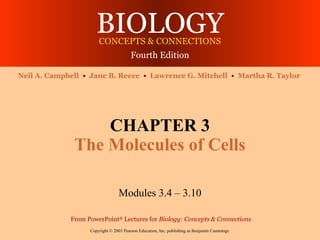
Carbohydrates, Proteins, Lipids and Nucleic Acids
- 1. BIOLOGY CONCEPTS & CONNECTIONS Fourth Edition Neil A. Campbell • Jane B. Reece • Lawrence G. Mitchell • Martha R. Taylor CHAPTER 3 The Molecules of Cells Modules 3.4 – 3.10 From PowerPoint® Lectures for Biology: Concepts & Connections Copyright © 2003 Pearson Education, Inc. publishing as Benjamin Cummings
- 2. CARBOHYDRATES • Carbohydrates are a class of molecules – They range from small sugars to large polysaccharides – Polysaccharides are long polymers of monomers Copyright © 2003 Pearson Education, Inc. publishing as Benjamin Cummings
- 3. 3.4 Monosaccharides are the simplest carbohydrates • Monosaccharides are single-unit sugars • These molecules typically have a formula that is a multiple of CH2O • Each molecule contains hydroxyl groups and a carbonyl group • Monosaccharides are the fuels for cellular work Figure 3.4A Copyright © 2003 Pearson Education, Inc. publishing as Benjamin Cummings
- 4. • The monosaccharides glucose and fructose are isomers – They contain the same atoms but in different arrangements Figure 3.4B Glucose Fructose Copyright © 2003 Pearson Education, Inc. publishing as Benjamin Cummings
- 5. • Many monosaccharides form rings, as shown here for glucose Abbreviated structure Figure 3.4C Copyright © 2003 Pearson Education, Inc. publishing as Benjamin Cummings
- 6. 3.5 Cells link single sugars to form disaccharides • Monosaccharides can join to form disaccharides, such as sucrose (table sugar) and maltose (brewing sugar) Glucose Glucose Sucrose Figure 3.5 Maltose Copyright © 2003 Pearson Education, Inc. publishing as Benjamin Cummings
- 7. 3.6 Connection: How sweet is sweet? • Various types of molecules, including non- sugars, taste sweet because they bind to “sweet” receptors on the tongue Table 3.6 Copyright © 2003 Pearson Education, Inc. publishing as Benjamin Cummings
- 8. 3.7 Polysaccharides are long chains of sugar units • These large molecules are polymers of hundreds or thousands of monosaccharides linked by dehydration synthesis Copyright © 2003 Pearson Education, Inc. publishing as Benjamin Cummings
- 9. • Starch and glycogen are polysaccharides that store sugar for later use • Cellulose is a polysaccharide in plant cell walls Starch granules in Glucose STARCH potato tuber cells monomer Glycogen granules GLYCOGEN in muscle tissue Cellulose fibrils in a plant cell wall CELLULOSE Cellulose molecules Figure 3.7 Copyright © 2003 Pearson Education, Inc. publishing as Benjamin Cummings
- 10. 3.8 Lipids include fats, which are mostly energy- storage molecules • These compounds are composed largely of carbon and hydrogen – They are not true polymers – They are grouped together because they do not mix with water Figure 3.8A Copyright © 2003 Pearson Education, Inc. publishing as Benjamin Cummings
- 11. • Fats are lipids whose main function is energy storage – They are also called triglycerides • A triglyceride molecule consists of one glycerol molecule linked to three fatty acids Fatty acid Figure 3.8B Copyright © 2003 Pearson Education, Inc. publishing as Benjamin Cummings
- 12. • The fatty acids of unsaturated fats (plant oils) contain double bonds – These prevent them from solidifying at room temperature • Saturated fats (lard) lack double bonds – They are solid at room temperature Figure 3.8C Copyright © 2003 Pearson Education, Inc. publishing as Benjamin Cummings
- 13. 3.9 Phospholipids, waxes, and steroids are lipids with a variety of functions • Phospholipids are a major component of cell membranes • Waxes form waterproof coatings • Steroids are often hormones Figure 3.9 Copyright © 2003 Pearson Education, Inc. publishing as Benjamin Cummings
- 14. 3.10 Connection: Anabolic steroids and related substances pose health risks • Anabolic steroids are usually synthetic variants of testosterone • Use of these substances can cause serious health problems Figure 3.10 Copyright © 2003 Pearson Education, Inc. publishing as Benjamin Cummings
